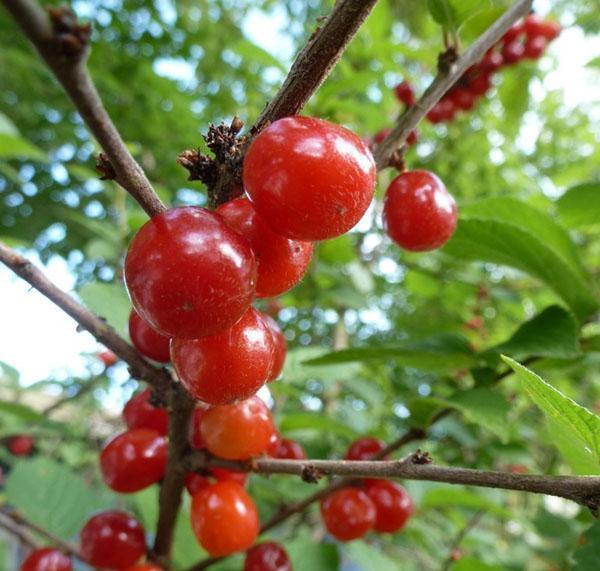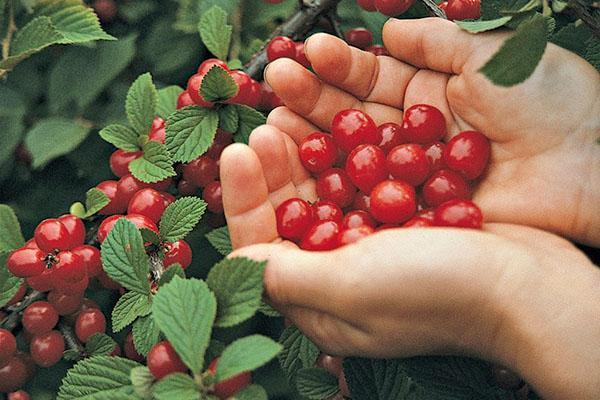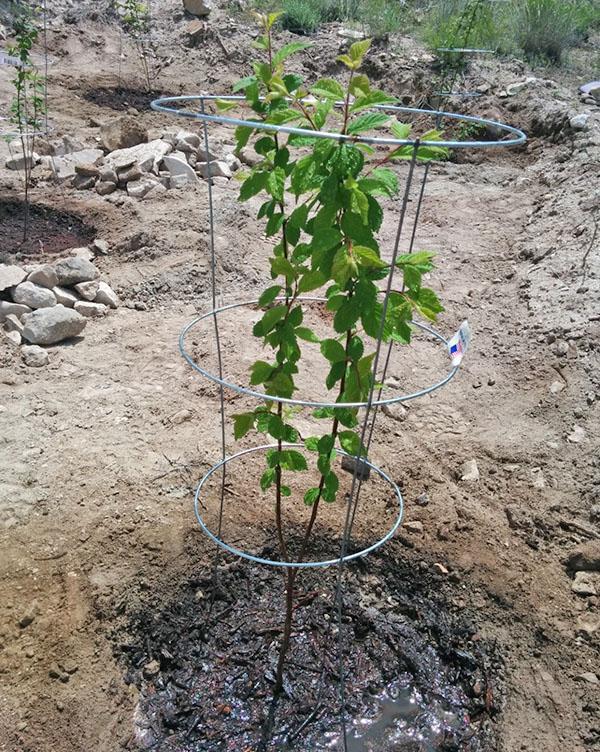Planting, growing, pruning and caring for felt cherries
 For gardeners in Europe felt cherry known since 1870, when this beautiful plant was first brought from China to the British Isles, and then to the New World. The culture immediately interested gardeners in its versatility, rapid growth and the fact that planting, growing, pruning and caring for felt cherries were easy and not burdensome.
For gardeners in Europe felt cherry known since 1870, when this beautiful plant was first brought from China to the British Isles, and then to the New World. The culture immediately interested gardeners in its versatility, rapid growth and the fact that planting, growing, pruning and caring for felt cherries were easy and not burdensome.
The natural area of fruit crops covers many parts of China, including Tibet, as well as Mongolia, the Korean Peninsula and part of the provinces of India. Therefore, an unusual cherry, which, according to the modern classification, is still classified as a plum, is called dwarf or mountain Chinese, Korean, Manchu, Shanghai or Nanking.
Description and features of growing felt cherry

Fruit shrub with brown-copper, in places darker, almost black bark does not exceed 1–3 meters in height. The branches are covered with oval toothed green leaves with a pointed tip, 2 to 7 m long, depending on the variety and age of the plant. They are strongly corrugated and sit on short, barely visible petioles. In the spring, the felted cherry is covered with a cloud of white or pink flowers that unfold even before the foliage begins to emerge.
The resulting fruits resemble traditional cherries, but are slightly smaller.
Today's interest in culture is understandable:
- Fruiting of felt cherries occurs in the first half of summer, when the ovaries are just forming on other stone fruit crops.
- The fruits of this Asian culture, due to their lower acid content, are sweeter than the berries of common varieties of ordinary cherries and are successfully used fresh, as raw materials for jam, juice and homemade wine, added to marinades and pickles.
- Felt cherry planting with proper care and pruning is excellent hedge.
- Plants easily adapt to the conditions of the middle zone, they are drought-resistant, cold-resistant.
Therefore, growing and caring for felt cherries does not require a lot of time and knowledge, even for novice gardeners.
Planting and caring for felt cherries
 Felt cherry is not demanding on the composition and fertility of the soil, but it feels better on light soils that are well permeable to moisture and air with a neutral reaction. If it is planned to plant this crop on the site, you need to pick up a sunny, wind-protected place where the plant's root system will not be threatened by close groundwater or stagnant rain and melt moisture. It is especially important that the planting site of the felt cherry is not at risk in the spring when massive snow melts.
Felt cherry is not demanding on the composition and fertility of the soil, but it feels better on light soils that are well permeable to moisture and air with a neutral reaction. If it is planned to plant this crop on the site, you need to pick up a sunny, wind-protected place where the plant's root system will not be threatened by close groundwater or stagnant rain and melt moisture. It is especially important that the planting site of the felt cherry is not at risk in the spring when massive snow melts.
Felt cherry is considered self-fertile, so several plants of different varieties are planted on the site.
With good care and pollination, an adult shrub or miniature tree of this culture can produce up to 8–12 kg of sweet berries, completely strewn with branches. Moreover, the best yields are observed on plants planted at some distance from each other. Crowding interferes with the work of pollinating insects, leads to excessive density and the risk of developing diseases.
Felt cherries are planted in autumn, choosing the time so that the plants have time to acclimatize. If the felted cherry seedlings are purchased too late, they can overwinter and wait for spring in a cool basement. In this case, it is better to mix the roots into a container and sprinkle with soil. In the spring, seedlings of felt cherries are transferred to the ground until the buds swell. Before planting, the root system is carefully examined, dry or damaged parts are removed.
 Annual or biennial plants are planted at a distance of 1.5–3 meters from each other. Planting pits with a depth of at least 50 and a width of 60 cm are equipped in advance. If necessary, the soil is deacidified, mineral and organic fertilizers... Per cubic meter of soil mixture should account for:
Annual or biennial plants are planted at a distance of 1.5–3 meters from each other. Planting pits with a depth of at least 50 and a width of 60 cm are equipped in advance. If necessary, the soil is deacidified, mineral and organic fertilizers... Per cubic meter of soil mixture should account for:
- 25-30 grams of potash fertilizers;
- 55-60 grams of phosphorus;
- from 6 to 10 kg of humus or well-rotted manure.
It is important not to deepen the root collar, otherwise the area sensitive to an excess of moisture will inevitably rot, the shrub grows poorly or may die altogether.
When the planting holes are filled up, the soil must be carefully compacted, the bushes must be watered, and then the soil surface under them must be sprinkled with mulch.
Care of felt cherries when grown in a personal plot
 Fruit shrubs, especially in the first years of life, need attention and competent care. Therefore, the soil under the felt cherry seedlings is necessary:
Fruit shrubs, especially in the first years of life, need attention and competent care. Therefore, the soil under the felt cherry seedlings is necessary:
- timely release from weeds that draw off nutrients and moisture;
- loosen, providing aeration of the soil and access to the root system of water and air;
- moisturize, especially during active vegetation.
With good care, soon after planting, the felt cherry begins to bear fruit, annually increasing the long-awaited yields:
- The grafted cuttings form ovaries for the next year
- Green felt cherry seedlings give their first berries two years after planting.
- Seedlings are covered with flowers in the fourth year of life.
The peel of the berries is rather thin, and although ripe fruits can remain on the branches for a long time, you should not abuse it. After a while, the berries wither quickly, and in wet weather they can rot.
At home, felt cherries are used to make preserves and jams, juice and jelly, wine and liqueurs. The berry, rich in vitamins and other useful substances, has a wonderful dessert taste and is loved by adults and children.
When growing felt cherries, the care on it includes protecting plants from pests and diseases of fruit crops. Care is required here, since the foliage and young growth, which are more tender than those of related crops, are easy to burn. The berries on the branches ripen almost at the same time, so when they are massively formed, the plants spend a lot of energy and need regular feeding. It is carried out by analogy with the fertilization of ordinary cherries.
Another mandatory care measure when growing felt cherries, in the photo, is pruning rapidly growing bushes or small trees that are prone to excessive crown density.
Felt Cherry Pruning
 Among fruit crops, felt cherry more than others needs proper, regular crown formation and sanitary pruning. Otherwise, the growing lateral shoots block access to the inside of the crown of air, light and insects that produce pollination. But in such conditions, pests, disease-causing bends, lichens feel great. Productivity drops, and the shrub may die over time.
Among fruit crops, felt cherry more than others needs proper, regular crown formation and sanitary pruning. Otherwise, the growing lateral shoots block access to the inside of the crown of air, light and insects that produce pollination. But in such conditions, pests, disease-causing bends, lichens feel great. Productivity drops, and the shrub may die over time.
Pruning felt cherries, as in the photo, are best carried in early spring, when the buds have not yet awakened on the plants and the juices have not begun to move. In this case, all the forces of the plant are directed to its growth, active flowering and the formation of large healthy berries.
The formation of the bush begins from the first year of life, which allows you to get a balanced strong crown, ready to give significant yields, in 2–3 years.
The procedure involves cutting:
- lateral branches directed deep into the crown;
- weak, frozen or dried out shoots during wintering;
- old branches that no longer participate in fruiting and do not have an annual growth;
- an excessive number of branches, the fruit of which will be difficult for the cherry to maintain.
Pruning of an adult felt cherry shrub is carried out in such a way as to leave no more than 12 strong shoots. Since the main crop is on one-year-old branches, in order to rejuvenate plants older than 8–10 years old, they are subjected to stronger pruning, gradually cutting out and replacing old skeletal branches with new shoots.
 If the felt cherry was not pruned in the spring, it is done in the fall. At the same time, attention is drawn to the new growth. Warm autumn provokes increased growth of new shoots, which are not ready for wintering and freeze out. Therefore, one-year-old branches longer than 60 cm are best cut off by a third. In addition, in the fall, sanitary processing of fruit shrubs is necessary. Fallen foliage is removed from under the crown, dried and damaged shoots are removed. Plant residues and cut branches are burned, large cuts with a diameter of more than 2 cm are treated with garden pitch.
If the felt cherry was not pruned in the spring, it is done in the fall. At the same time, attention is drawn to the new growth. Warm autumn provokes increased growth of new shoots, which are not ready for wintering and freeze out. Therefore, one-year-old branches longer than 60 cm are best cut off by a third. In addition, in the fall, sanitary processing of fruit shrubs is necessary. Fallen foliage is removed from under the crown, dried and damaged shoots are removed. Plant residues and cut branches are burned, large cuts with a diameter of more than 2 cm are treated with garden pitch.
Reproduction of felt cherries
 There are several ways to get new felt cherry plants in a personal plot. The easiest and fastest way to get seedlings is from rooted green cuttings. The only drawback is the risk of decay of the root collar of such plants after wintering.
There are several ways to get new felt cherry plants in a personal plot. The easiest and fastest way to get seedlings is from rooted green cuttings. The only drawback is the risk of decay of the root collar of such plants after wintering.
Lignified branches form roots much worse, and viable seedlings of felt cherries can be obtained from them only in a greenhouse with constantly high air humidity.
The culture is also propagated by layering, rooting a young shoot leaning to the soil, and enthusiasts can start growing and caring for felt cherries obtained from seeds. In this case, it is not always possible to preserve the original varietal characteristics, but the method opens up wide possibilities for experiments with selection. Felt cherry can be crossed with cherry plum, apricot and some varieties of plum. However, cherries can be grafted onto the seedlings of these crops with a handle or an eye.